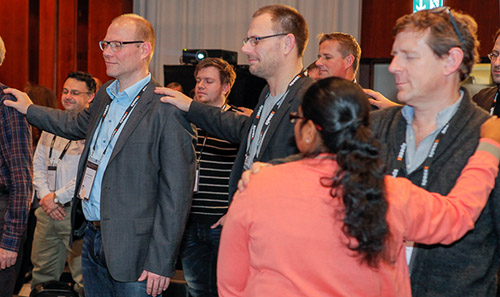As I hinted at in my (Re)humanising eLearning post I directed a group performance entitled “A performance of connection and anxiety” as part of my Spotlight Stage session at Online Educa. The audience played the part of first year undergraduates while I represented ‘the institution’ in all its various forms. This involved everyone standing up, putting their hand on the next person’s shoulder and closing their eyes (100+ people seemed surprisingly willing to enter into this piece of shared theater).

As I’d hoped this created a certain frisson in the room and when we remained silent for about 15 seconds that strange feeling of togetherness started to grow despite most of the audience being strangers to one other. I then circulated round the room ‘selecting’ individuals by tapping them on the shoulder while they had their eyes closed, representing the moments they might be ‘chosen’ or engaged with by your institution in some way.
Discussing this with people afterwards some commented that they had hoped to be chosen but they didn’t know why as I hadn’t explained what the implications would be. Others hoped not to be chosen but overall there was a healthy tension in the room – I like to think of this as the ‘good’ form of anxiety.
When I asked everyone to open their eyes and sit down if they hadn’t been selected many people were looking around to see who the chosen few were. At this point I admitted that I hadn’t chosen anyone which fortunately got a laugh (possibly of relief :).
Overall it did feel like we’d all shared in a specific moment of connection and one, as I outline in the original post, which worked between strangers because we were physically co-present. Gaining that sense of connection online requires more up-front identity work but I believe it’s crucial if we see the value of the digital as a place we can learn together.
The three key areas I proposed for consideration to create connection online and rehumanise elearning were:
1. Spaces
Think of and use the digital as a series of spaces or places where individuals can be co-present and connected. (rather than just a mechanism to broadcast content)
2. Eventedness
Design in synchronous moments or ‘events’ online. This helps to create a feeling of belonging and that ‘I was there’ factor. The technology to support this is now pretty reliable.
3. Conversation at scale
Design mechanisms for discourse to take place at scale. Hashtags, commenting, shared postings, crowd-sourcing, editathons etc. This is the area which we are least adept at but I believe the technology is now in place to support conversation at scale if we can design our teaching to take advantage of it.
All of the above are underpinned by individual’s developing an online presence and identity. Something which is central to almost all Digital Literacy frameworks but which we often don’t prioritise when supporting our students and/or staff.

